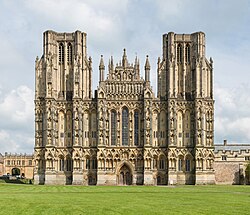| Wells Cathedral | |
|---|---|
| Cathedral Church of St Andrew | |
 West front of Wells Cathedral | |
 | |
| 51°12′37″N 2°38′37″W / 51.2104°N 2.6437°W | |
| Location | Wells, Somerset |
| Country | England |
| Denomination | Church of England |
| Previous denomination | Roman Catholic |
| Website | wellscathedral |
| History | |
| Dedication | Saint Andrew |
| Consecrated | 23 October 1239 |
| Architecture | |
| Heritage designation | Grade I listed building |
| Designated | 12 November 1953[1] |
| Style | Gothic (Early English, Decorated, and Perpendicular) |
| Years built | 1176 – c. 1490[1][2] |
| Specifications | |
| Length | 126.5 m (415 ft)[3] |
| Width | 20 m (66 ft)[3] |
| Width across transepts | 47 m (154 ft)[3] |
| Nave height | 20.5 m (67 ft)[3] |
| Number of towers | 3 |
| Tower height | |
| Bells | 10 |
| Administration | |
| Province | Canterbury |
| Diocese | Bath and Wells (since c. 909) |
| Clergy | |
| Bishop(s) | Michael Beasley |
| Dean | Toby Wright |
| Precentor | Mary Bide (Acting) |
| Chancellor | Megan Daffern |
| Archdeacon | Anne Gell (Wells) |
| Laity | |
| Organist(s) | Alexander Hamilton (Acting)[4] |
Wells Cathedral, formally the Cathedral Church of St Andrew, is a Church of England cathedral in Wells, Somerset, England. It is the seat of the bishop of Bath and Wells and the mother church of the diocese of Bath and Wells. There are daily Church of England services in the building, and in 2023 it was reported to receive over 300,000 visitors per year.[5] The cathedral is a Grade I listed building.[1] The cathedral precincts contain the Bishop's Palace and several buildings linked to its medieval chapter of secular canons, including the fifteenth-century Vicars' Close.[6]
The earliest record of a church on the present site is a charter of 766.[1] A bishopric was established in 909, however in 1090 the cathedral of the diocese was moved to Bath Abbey and remained there until Wells became co-cathedral in 1218.[1][7] The remains of the tenth-century cathedral lie to the south of the present building, beneath the cloister. The present cathedral has a cruciform plan with a chapter house attached to the north and a cloister to the south, and is largely the result of two building campaigns which took place between c. 1180 to c. 1260 and c. 1285 to c. 1345. The western half of the cathedral, including the nave and western transepts, belongs primarily to the first building phase and is constructed in the Early English style of Gothic architecture. The east end, including the lady chapel, eastern transepts, chapter house, and central tower, belongs to the second phase and uses the Decorated Gothic style; it also retains much medieval stained glass.[1][7][8] Two towers were added to the west front between 1385 and 1410 in the Perpendicular Gothic style, and the cloisters were remodelled in the same style between 1420 and 1508. The cathedral was restored over the course of the nineteenth and early twentieth centuries.[1][7]
Wells has been called "unquestionably one of the most beautiful" and "most poetic" of English cathedrals.[9][8] The architectural historian John Harvey sees it as Europe's first truly Gothic structure, breaking from the last constraints of the Romanesque style.[10] The west front, which contains 300 sculpted figures,[8] has been described by Harvey as the "supreme triumph of the combined plastic arts in England",[11] however the architectural historian Nikolaus Pevsner described it as "spare", with "harsh uprights and horizontals [...] like steel scaffolding".[7]
- ^ a b c d e f g Historic England. "Cathedral Church of St Andrew, Chapter House and Cloisters (1382901)". National Heritage List for England. Retrieved 5 January 2013.
- ^ "Wells Cathedral – Wells, Somerset". Archived from the original on 10 April 2021. Retrieved 17 June 2022.
- ^ a b c d e f "Dates and Dimensions" (Word). Wells Cathedral. Archived from the original on 3 December 2013.
- ^ "Organists". Wells Cathedral. Retrieved 25 February 2023.
- ^ "New Constitution and Statutes for Wells Cathedral". Wells Cathedral. 30 November 2023. Retrieved 23 October 2024.
- ^ Swaan 1984, pp. 188–196.
- ^ a b c d Pevsner, Nikolaus; Metcalf, Priscilla; et al. (and various hands) (1985). The Cathedrals of England: the West and Midlands. London: The Folio Society (published 2005). pp. 251–293.
- ^ a b c Clifton-Taylor 1967, p. 274.
- ^ Oggins, Robin. Cathedrals Archived 4 May 2018 at the Wayback Machine, p. 42 (Sterling Publishing Company 1996).
- ^ Harvey 1987, p. 19.
- ^ Harvey 1961, p. 63.